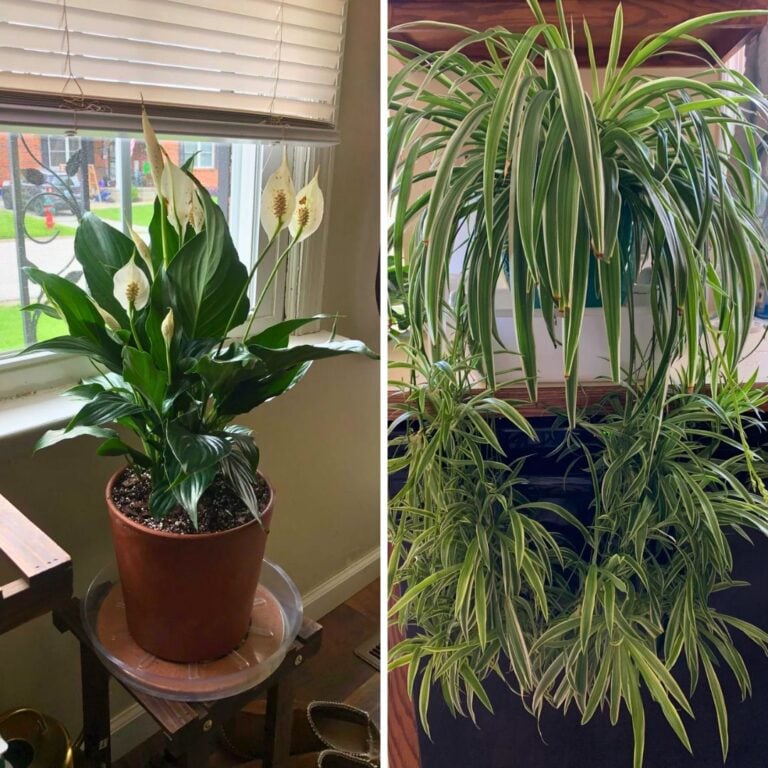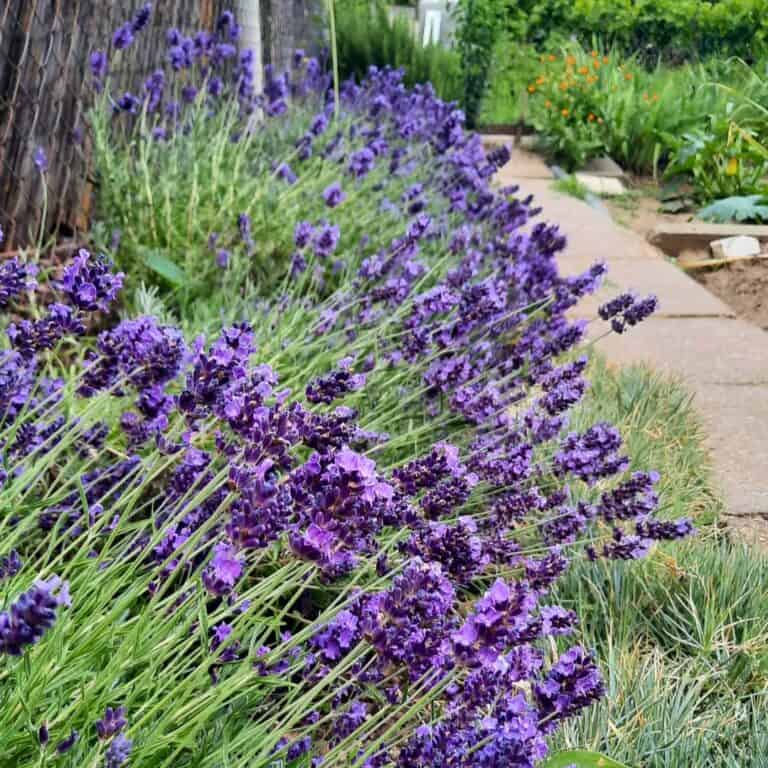20 Best Snake-Repellent Plants For Your Garden
I love hanging out in my garden, but honestly, seeing a snake slither by is enough to make me jump.
If you’re after a peaceful, safe spot to enjoy your plants, you can actually use nature’s own tricks to keep snakes at bay.
Turns out, you can grow certain plants that naturally repel snakes, and your garden will still look gorgeous and feel healthy.
In this article, I’ll share some of my favorite snake-repellent plants you can add to your garden.
You’ll get tips on how these plants work, how to grow them, and a few pointers on caring for them so they stay happy and effective.
Please note: Simplify Plants is reader-supported. As an Amazon Associate, I earn from qualifying purchases made by our readers with no extra cost added to you all! Some links in the post are affiliate links and I get a commission from purchases made through links in the post.
1) Marigold

I love planting marigolds for their splash of color and how they help my garden thrive. Those bold orange and yellow blooms are hard to miss and always brighten things up.
Marigolds have a strong scent that’s not a favorite with pests or snakes. I’ve noticed that when I tuck them in around my garden beds, snakes usually steer clear. The smell just seems to put them off.
They do best in full sunlight and well-drained soil. I keep them watered, but I’m careful not to let the soil get soggy. These are tough little plants that don’t mind the heat or dry spells.
I like to plant marigolds along garden borders or near spots where snakes might sneak in. Not only do they help protect the garden, but they also attract bees and butterflies, which is always a plus.
Deadheading the faded flowers really does help marigolds keep blooming longer. I just pinch off the old ones and new blooms seem to pop up fast.
Marigolds mix well with herbs and veggies, adding color and cutting down on pests without chemicals. For me, they’re a practical—and pretty—choice for keeping my garden lively and safe.
2) Mother-in-Law’s Tongue

I’m a big fan of Mother-in-Law’s Tongue, or Snake Plant. Its tall, upright leaves give the garden a clean, modern vibe, and honestly, it’s about as easy-care as it gets.
This plant is known to discourage snakes because of its sharp, pointed leaves. The stiff, upright growth just isn’t comfortable for snakes to slither through, so I like to plant it along fences or garden edges to make a natural barrier.
It grows well in pots or right in the soil, so I can move it wherever I need a bit of extra protection. It doesn’t ask for much—just the occasional drink of water—and it’s happy in sun or shade.
Another thing I love is that it helps clean the air by filtering out toxins. Makes the garden feel fresher, honestly.
If you want something low-maintenance that looks good and helps keep snakes away, Mother-in-Law’s Tongue is a solid pick. It stays green all year and doesn’t mind being left alone.
3) Lemongrass

I really enjoy growing lemongrass—it smells so fresh and looks great swaying in the breeze. Those tall, thin leaves give off a clean citrus scent that I find pretty uplifting.
That scent is also why snakes aren’t fans. When I plant lemongrass around the yard, I see fewer pests in general. The strong smell seems to throw off insects and little critters, which means snakes (who eat those critters) are less likely to show up.
Lemongrass loves full sun and warm weather. I make sure the soil drains well, since soggy roots aren’t its thing. Once it’s settled in, I only water when the top soil feels dry.
I usually put lemongrass along fences or at the edge of the garden. The thick clumps look tidy and the scent is nice when I walk by. Trimming it now and then keeps it neat and encourages fresh growth.
If I want more, I just split a healthy clump and replant. It spreads easily, so I can fill empty spots without buying new plants. Sometimes I dry the leaves for tea or to use as a natural air freshener.
Lemongrass works best alongside other strong-scented herbs to make the garden less appealing to snakes. I like mixing it up for a more effective defense.
All in all, lemongrass is both useful and attractive. It keeps things smelling good, looks vibrant, and helps me feel more relaxed in the garden.
4) Garlic
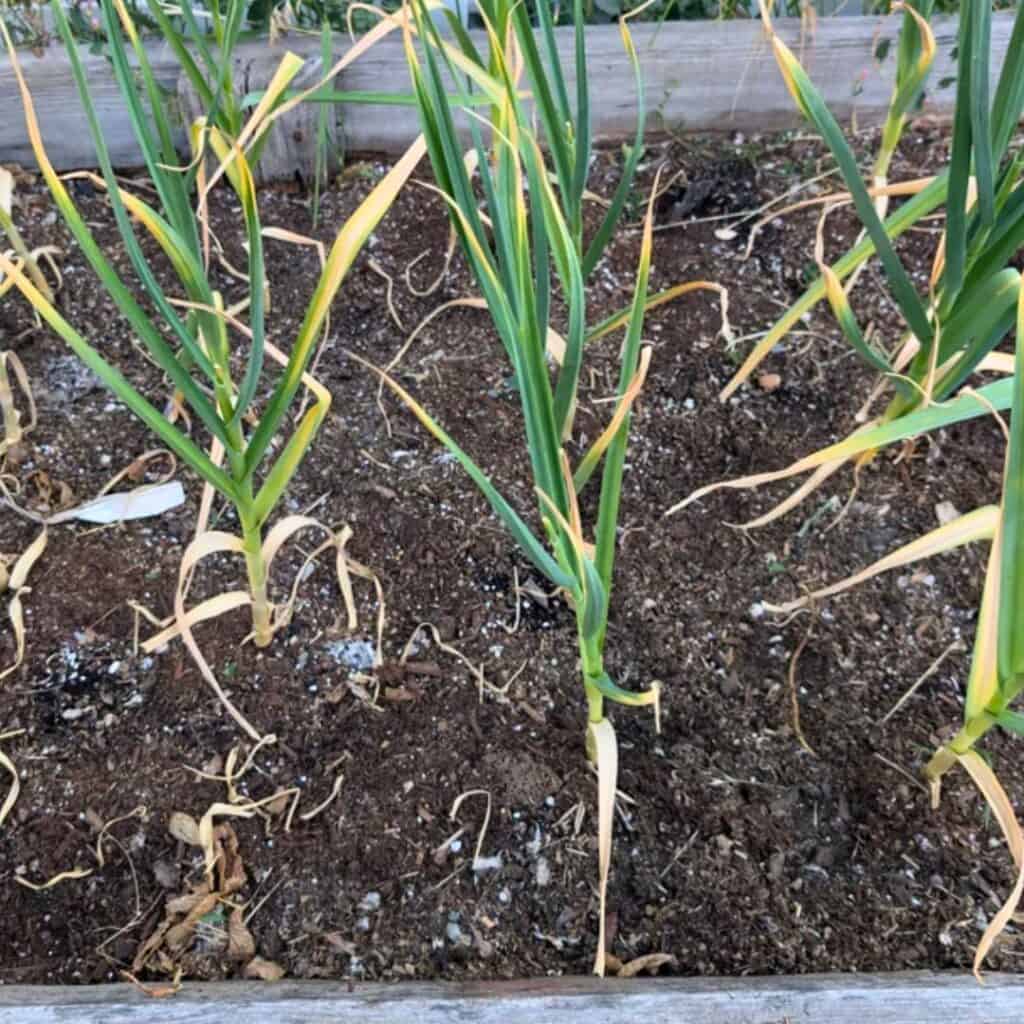
I like growing garlic because it’s simple and keeps pests at a distance. The strong smell is enough to make snakes think twice about hanging around, at least in my experience.
Garlic does best in well-drained soil and full sun. I plant the cloves a few inches deep and keep the soil just a bit moist. Not much fuss needed, which is perfect for busy days.
When the garlic’s ready, I sometimes crush a few cloves and scatter them near the garden edges. The scent gets stronger and might help create a barrier that snakes don’t enjoy.
I also love using the harvested bulbs in the kitchen, so it’s a win-win. Tasty meals and a more comfortable garden? Yes, please.
If you want something practical and easy, garlic is worth a try. It’s a little step that can make your outdoor space feel a lot more peaceful.
5) Onion

I like growing onions because they’re super useful in cooking and not hard to grow at all. What surprised me is that they can also help keep snakes away—the strong smell seems to bother them and makes them less likely to stick around.
I usually plant onions along the edges of my garden beds. It creates a mild barrier, and I’ve noticed fewer snake visits since I started.
The sulfur compounds in onions are what give them that sharp scent, and those same compounds are believed to make the area uncomfortable for snakes. Onions won’t completely get rid of snakes, but they support other natural deterrents.
They grow well in lots of climates. All they really need is full sun and well-drained soil. I keep them watered, but not too much—soggy soil isn’t their thing.
Onions also repel insects like aphids and beetles, so they’re good companions for tomatoes or peppers. I like that one plant can do so much.
If I have space, I’ll put a few rows near entry points—like by the shed or along the fence. Even if snakes don’t totally disappear, I feel better knowing I’m using a natural method.
Adding onions gives me both fresh produce and peace of mind. It’s an easy step that fits right into my gardening routine.
6) Wormwood

I really enjoy having wormwood in my garden. It’s a tough plant with silvery-gray leaves that look great against all the green. The soft color contrast is surprisingly calming.
Wormwood has a strong, bitter scent that pests—including snakes—don’t like. When I plant it around the borders, it helps create a natural barrier. I’ve noticed fewer unwanted critters where wormwood grows thick.
This plant does best in dry, well-drained soil and plenty of sun. I hardly ever have to water it, which is a relief. It’s drought-tolerant and pretty much takes care of itself.
One thing I appreciate is that wormwood doesn’t spread like crazy. It stays put, so I can manage its size easily. A trim once or twice a year keeps it looking tidy.
Because of the strong aroma, I don’t plant it too close to herbs or veggies I plan to eat—sometimes the scent can affect their flavor. Instead, I use wormwood as a border plant or near paths where I want a little extra protection.
The natural oils in wormwood are what give it those repellent qualities. Some folks dry the leaves and put them around sheds or fences. I’ve tried it, and it seems to help keep pests out of storage areas.
If you want a plant that looks cool and helps keep snakes away, wormwood is a great option. It’s hardy, easy to grow, and adds a unique touch to the garden.
7) Rue

I like growing rue because it’s both pretty and practical. The small, bushy herb has blue-green leaves that really pop in the garden.
Rue thrives in sunny, dry spots and doesn’t need much attention once it’s settled. I’ve noticed snakes avoid areas where rue grows, probably because of its strong scent and bitter oils.
I always wear gloves with rue since its sap can irritate the skin. A little care when trimming goes a long way, but it’s still easy to manage.
Rue attracts butterflies and discourages other pests, so it adds both beauty and function. Pairing it with other repellents like lemongrass or marigolds makes for a stronger natural defense.
I usually plant rue near fences and garden edges. Its compact shape fits well with other herbs and flowers, and with some sun and well-drained soil, it stays healthy.
If you’re after a low-maintenance plant that helps keep your garden safer, rue is a smart pick. It’s hardy, useful, and adds a little charm to any outdoor space.
8) Chrysanthemum

I’ve always enjoyed growing Chrysanthemums—they just light up the garden with those colorful blooms. They come in so many shades, from sunny yellow to soft pink, and honestly, they keep things looking cheerful for ages.
What’s really neat is that their natural scent helps keep snakes away. Apparently, snakes aren’t fans of the smell, so they steer clear. I like planting them along fences or walkways for a mix of color and a little extra peace of mind.
Chrysanthemums also bring in bees and butterflies, which makes the garden feel alive. I appreciate that I don’t have to rely on chemicals since these flowers do some of the pest control for me.
They do best in sunny spots with well-drained soil. I try not to overwater—just enough to keep them happy. With a bit of attention, they’ll bloom for weeks and really freshen up the space.
I often mix Chrysanthemums with other snake-repelling plants like marigolds or lemongrass. The combo looks great and, bonus, smells nice to me but not to the critters I’d rather avoid.
If you’re after a plant that adds color and cuts down on unwanted guests, Chrysanthemums are a smart choice. They’re easy to find, simple to grow, and honestly fit in with just about any garden vibe.
9) Peppermint

I can’t get enough of peppermint in my garden—it just smells so fresh, and the whole area feels more lively. The strong scent isn’t just for me; it actually helps discourage snakes from hanging around, which is a nice perk.
The smell can mess with their sense of direction, so they’re less likely to stick around. Peppermint grows fast and can take over if you let it, so I usually keep it in pots or containers.
That way, it doesn’t run wild. I like to set the pots near walkways, patios, or shady corners where snakes might sneak in.
It’s also great for attracting pollinators like bees and butterflies, which helps everything else grow better. The little green leaves and soft purple flowers look good next to other herbs, too.
Peppermint’s pretty low-maintenance. It likes regular watering but doesn’t need much fussing over besides a trim now and then. When I crush a few leaves, the scent really kicks up, and that seems to make the area even less appealing to snakes.
If I want a little extra punch, I’ll whip up a quick peppermint spray—just a few drops of peppermint oil mixed with water. I spray it around garden edges, rocks, and fences. It’s quick, natural, and keeps the scent fresh.
For me, peppermint is just an all-around winner. The garden smells clean, looks good, and I can always use the leaves for tea or other homemade stuff. It’s easily one of my favorite plants to keep around.
10) Lavender

I always make room for lavender in my garden. Those soft purple flowers are beautiful, and the scent is just unbeatable. Bees and butterflies seem to love it, which livens the place up.
On top of that, the strong fragrance helps keep snakes and insects away. I’ve heard snakes really dislike that sharp lavender smell.
I usually plant it along borders or near walkways, and it seems to create a gentle but effective barrier. The scent lingers, especially when there’s a breeze.
Lavender likes sunny, dry areas with soil that drains well. I go easy on the watering; too much and the roots get fussy. Once it’s settled in, it barely needs any care.
I sometimes dry the flowers and leave little bundles near doors or windows. It keeps the house smelling nice and might even keep some pests outside.
If you want something useful and attractive, lavender is a solid pick. It brings color, fragrance, and a bit of extra protection to the garden.
11) Rosemary

I’ve always liked growing rosemary—it smells great and looks good all year round. The scent is strong enough to help keep snakes away, and they apparently don’t care for the thick leaves either.
Rosemary does best in sunny, dry areas with soil that drains well. I give it a light watering and trim it often to keep it looking neat. It’s so low-maintenance, which is great if you’re busy (like me).
I plant it near walkways, patios, and the edges of the garden. The dense growth makes a natural barrier, and I’ve noticed fewer pests since adding it.
Besides pest control, rosemary is handy in the kitchen. I snip sprigs for seasoning veggies or meat—nothing beats fresh herbs from the garden.
Brushing past the leaves releases that fresh scent, and it just makes the garden feel more inviting. I like knowing this simple herb adds both beauty and a little extra safety to my space.
12) Thyme

I like growing thyme because it’s just so easy and it smells really nice. It’s a small herb that’s great for cooking, and it keeps the garden feeling fresh.
Thyme’s strong scent can make snakes think twice about hanging around. The oils in the leaves give off a smell that a lot of pests, including snakes, just don’t like. I tuck it near borders or walkways to help build a natural barrier.
It thrives in sunny, dry spots with well-drained soil. Thyme doesn’t like wet feet, so I go easy on the watering. Once it’s settled, it barely needs anything.
I trim it now and then to keep it tidy and encourage new growth. The more I prune, the bushier it gets, and I can use the trimmings in the kitchen or dry them for later.
Thyme attracts bees and other helpful insects, so the garden stays healthy. It’s nice to have a plant that supports pollinators and helps with pests.
I like mixing thyme with rosemary or lavender. The scents blend well and might help keep unwanted critters away.
If I plant thyme near paths or seats, I notice the scent more when I brush past it. It’s a simple way to enjoy the fragrance and get a bit of natural protection.
Since thyme stays low, it’s perfect as ground cover between stones or around bigger plants. It fills gaps and keeps things tidy without much work.
When planting, I give each thyme plant a little space. It starts slow but eventually forms a nice, thick mat. With some sun and a bit of care, it grows almost anywhere.
Thyme is both useful and attractive, easily one of my top herbs to grow. It makes the garden pleasant and helps keep pests down with minimal effort.
13) Sage

I like growing sage because it looks nice, smells even better, and helps keep unwanted pests away. The scent is strong, and I’ve noticed snakes don’t seem to like it much.
Sage has thick, textured leaves that release a sharp aroma when you touch them. I often brush against the plants when I water, which spreads the scent around.
It’s also great that sage attracts bees and butterflies while keeping snakes at bay. The purple flowers look lovely against the gray-green leaves.
This plant loves sunny, dry areas and barely needs water once it’s going. It’s easy to grow in pots or right along pathways.
I sometimes dry sage leaves for cooking or natural air fresheners. The smell that snakes dislike also keeps the garden smelling fresh.
Regular pruning keeps sage looking good and healthy. I trim it after it flowers to encourage new growth, and the aroma just gets stronger.
If you’re in a warm or mild climate, sage can stay green most of the year. I really like how it keeps the garden looking lively, even in cooler months.
Planting sage near entry points, rock borders, or garden beds can make a light barrier against snakes. It might not stop every single one, but I see them less often, and that’s a win in my book.
14) Basil
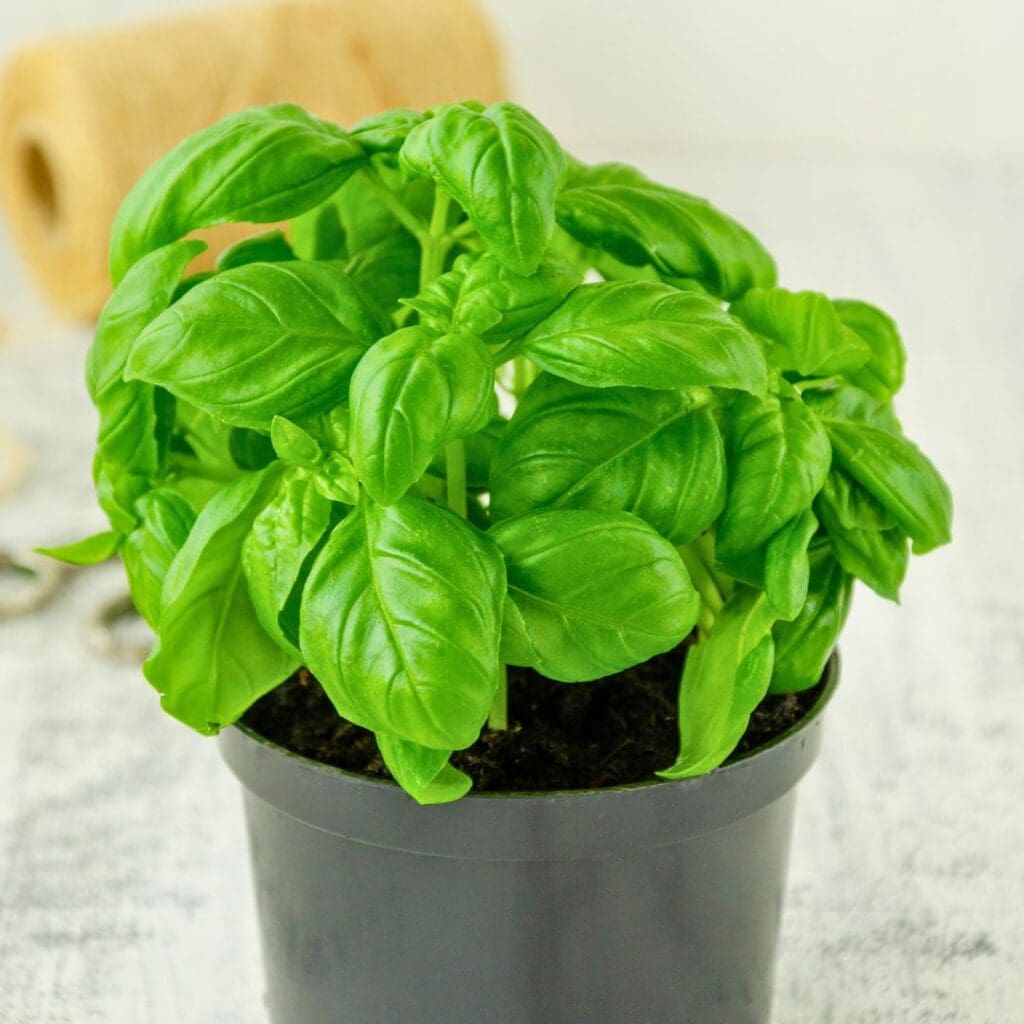
I love growing basil—it’s easy, smells amazing, and adds flavor to just about any meal. The strong scent seems to discourage snakes from hanging around, which is a nice bonus.
When I plant basil near doorways or patios, I notice fewer bugs and small pests. Since snakes often follow those pests, keeping them away helps cut down on snake visits too.
I usually grow basil in pots or garden beds with plenty of sunlight. It likes regular watering, but not soggy soil. Trimming the leaves often keeps it healthy and bushy.
Basil pairs well with tomatoes, peppers, and marigolds. I like how it fills out the garden, making it look green and full while serving a purpose.
If I want the scent to cover more ground, I’ll plant several bushes together. Plus, there’s always fresh basil for cooking—can’t complain about that.
15) Castor Bean Plant

I like adding the Castor Bean Plant to my garden because it just looks so bold and tropical. The big, glossy leaves and tall stems really stand out, and it grows fast enough to fill empty spots in no time.
I’ve read that snakes don’t like the strong scent of castor oil from this plant. That smell helps keep them away naturally, which is handy if you want to avoid chemical deterrents.
Just a heads-up—all parts of this plant are toxic if eaten. I keep it away from pets and kids, and I always wear gloves when handling it.
Castor Bean loves full sun and well-drained soil. I water it regularly but make sure it never sits in soggy ground.
I use it as a border plant or near fences for a natural barrier. The tall stems help with privacy, too.
Even though it’s not a plant I touch often, I appreciate how it helps with pests and snakes. It’s one of those plants that works hard without much fuss from me.
16) Daffodils

I love planting daffodils because they bring bright color to the garden early in spring. Those yellow and white blooms just make everything feel fresh after winter.
The best part is that snakes usually avoid daffodils. They’ve got natural compounds that can irritate snakes, so they tend to keep their distance. I like putting daffodils near borders or walkways for a simple, natural barrier.
These flowers are easy to grow. I just plant the bulbs in well-drained soil with plenty of sunlight, and once they’re established, they come back every year with almost no effort.
Daffodils look great mixed with other spring plants like tulips or hyacinths. They add variety and still help keep unwanted visitors out.
Since they bloom so early, daffodils kick off the growing season with a burst of color. I love seeing them pop up before anything else is awake.
If you’re after a plant that’s both beautiful and practical, daffodils are a great pick. They brighten the yard and might just help keep snakes at bay.
17) Fritillaria

I really enjoy having Fritillaria in my garden. It brings a pop of color and a bit of drama, and I’ve heard it’s pretty good at keeping snakes at bay.
This plant has a strong, musky smell that snakes aren’t too fond of. The scent comes from the bulbs, and it somehow manages to keep a lot of little critters away too.
I like planting Fritillaria along paths and at the edges of my garden. The flowers are tall and bell-shaped—honestly, they look pretty great in spring next to almost anything else I’ve got growing.
It’s not a fussy plant. As long as the soil drains well and there’s some sunlight, it seems happy enough.
After adding Fritillaria, I noticed I was spotting fewer snakes in my yard. It’s not a miracle cure, but it definitely helps make the space less appealing for them. I try to keep up with regular care and watering so they stay healthy.
There are some neat varieties, like Crown Imperial and Checkered Lily. Each one has its own personality when it comes to shape and color.
I like how they brighten up the garden and pull double duty as a natural deterrent. If you’re after something that’s both pretty and practical, Fritillaria is a solid pick.
18) Garlic Chives

I’m a big fan of garlic chives—they’re easy to grow, and the smell when you brush past them is just the best. That mild garlicky aroma is great in the kitchen and, as a bonus, seems to keep pests away.
The odor from garlic chives is strong enough that snakes tend to avoid the area. Since snakes use their sense of smell to get around, this plant can really throw them off.
I usually plant them along borders and near entry paths. They form tidy clumps, which look nice, and the white flowers draw in bees and butterflies. Watching all that activity is half the fun.
Garlic chives do well in full sun or partial shade, and they’re not picky as long as the soil drains. I water them regularly, but not too much—they hate having soggy feet.
They spread pretty fast, so I trim them back now and then to keep things under control. I also love that they’re useful in the kitchen.
I snip the leaves for soups, stir-fries, and salads. The flavor is fresh and mild, and the plant just keeps producing all season long.
If you want a natural way to discourage snakes and add some flavor to your meals, garlic chives are a smart choice. They’re practical, low-maintenance, and honestly look good year-round.
19) Curry Leaf Plant
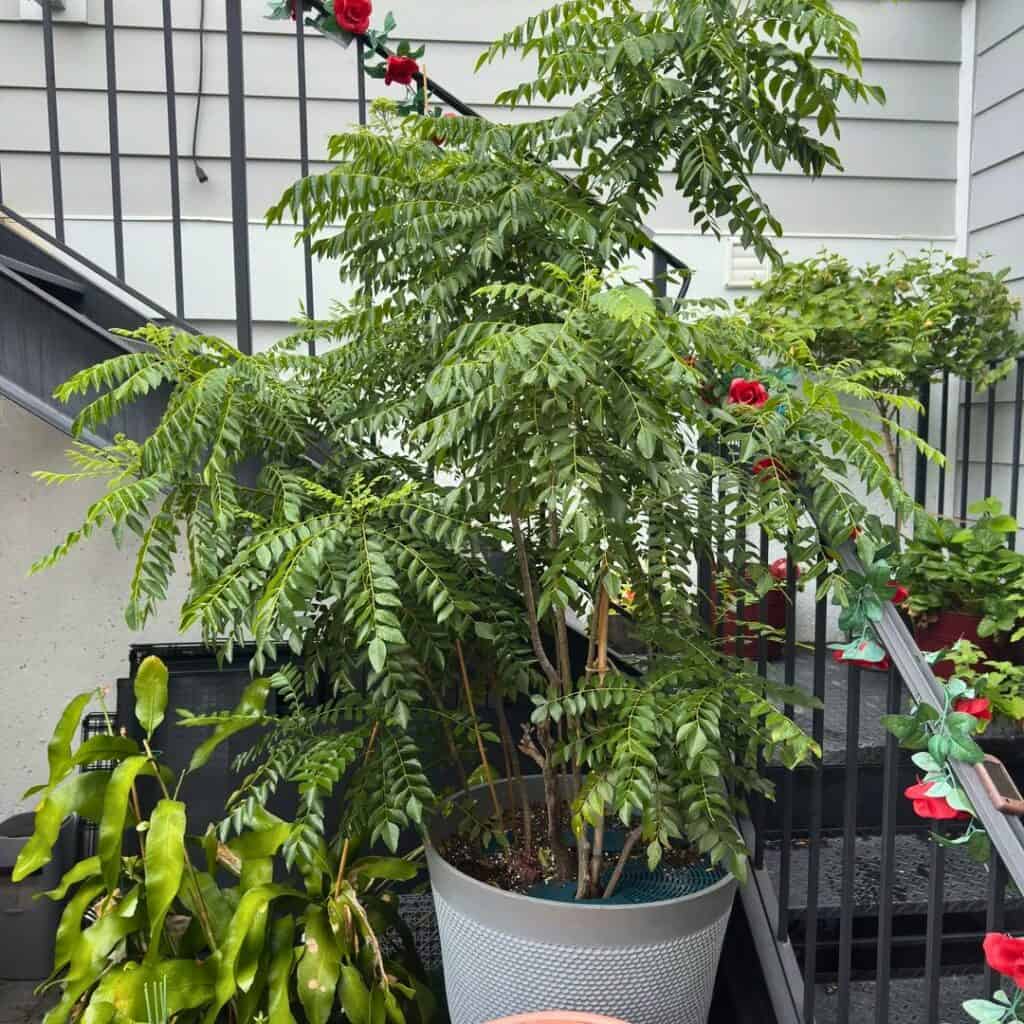
The Curry Leaf Plant is one of my favorites. It looks lovely, and the scent is just incredible—spicy, fresh, and a little bit exotic.
I’ve noticed that its strong aroma seems to keep snakes from getting too close. That’s a nice bonus, honestly.
It grows best in warm, sunny spots with soil that drains well. I water it regularly but try not to overdo it; soggy roots are a no-go.
The leaves are great in cooking. They add a deep, earthy flavor to dishes, and it’s pretty satisfying to pick them fresh.
I like planting curry leaf shrubs along fences or at the edge of the garden. The scent drifts around, and I see fewer pests and reptiles in those spots.
Once it’s established, it’s pretty easy to care for. A little trimming keeps it neat and helps encourage new growth.
If you let it, the plant will grow into a small tree, but I usually keep it pruned back.
Honestly, the Curry Leaf Plant is a solid choice if you want a simple, low-maintenance way to make your garden less appealing to snakes. It’s practical, smells amazing, and always catches my eye.
20) Eucalyptus
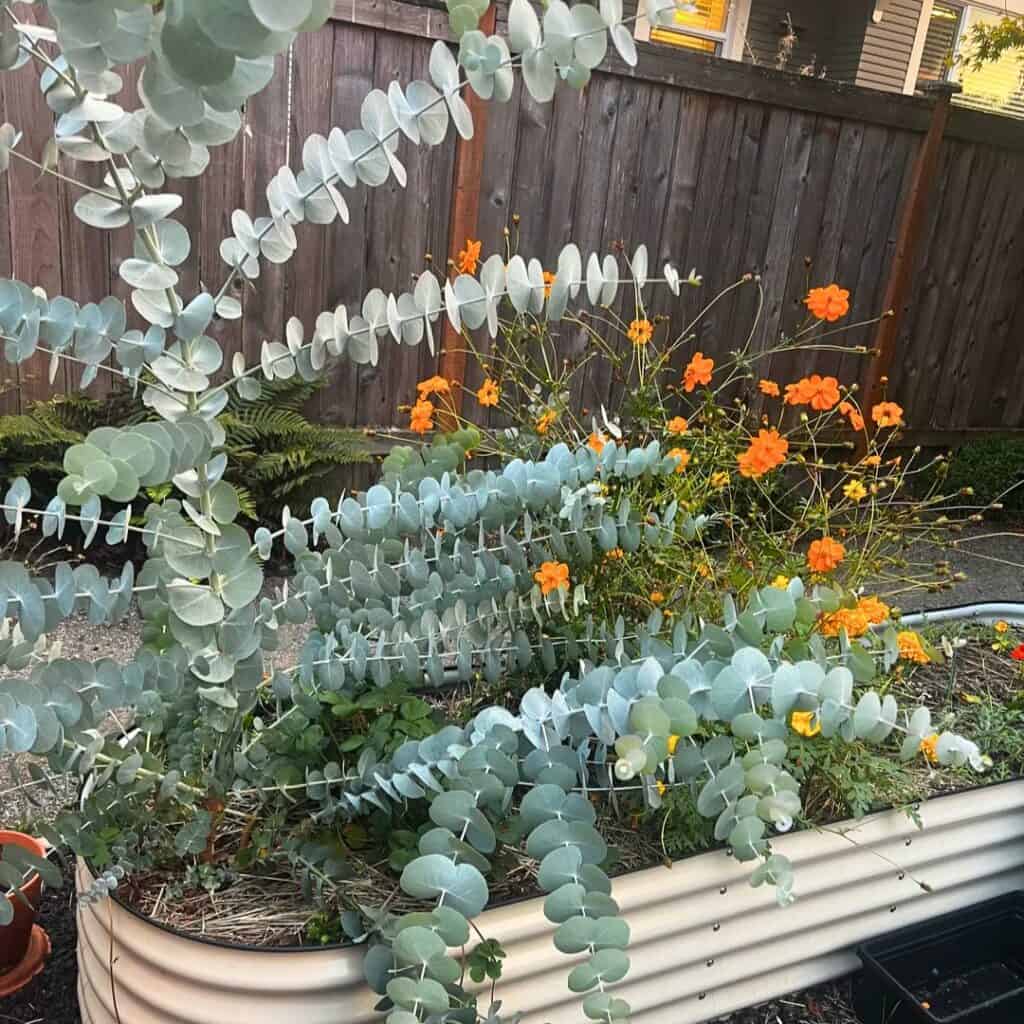
I have to say, I love growing Eucalyptus. It’s beautiful, and the fresh scent is one of my favorites.
Those tall stems and round leaves give the garden a calm, almost spa-like feel. The smell is strong but pleasant—hard to miss when you step outside.
Eucalyptus oil has a sharp, menthol-like aroma that a lot of animals (and insects) just can’t stand. I’ve definitely seen fewer unwanted visitors, snakes included, since I started growing it.
The natural oils in the leaves seem to make the area less appealing for them. I plant Eucalyptus in sunny spots with well-drained soil; it doesn’t ask for much once it’s settled in.
I water it when the soil feels dry and trim it to keep things tidy. The tree can get pretty tall, so I usually plant it near fences or at the back of the garden for some shade.
The bark is a soft gray, and the green leaves add a nice contrast. If I crush a few leaves, the scent gets even stronger—sometimes I scatter them near corners or entry points for an extra boost.
If you’re in a cooler area, you can grow Eucalyptus in large pots. I bring mine inside when it gets cold, and they keep their crisp aroma even indoors.
For me, Eucalyptus is both practical and decorative. It keeps the garden feeling peaceful, works naturally, and looks good in just about any setting.
How Snake-Repellent Plants Work
I’ve noticed some plants just seem to keep snakes away. They release strong smells and chemicals that snakes really don’t like.
These plants also change the feel of the garden, making it less comfortable for snakes to hang out or move through.
Natural Compounds That Deter Snakes
A lot of snake-repellent plants produce natural oils and compounds that mess with a snake’s sense of smell. Snakes use their Jacobson’s organ to pick up on scents, and when something strong or unpleasant hits it, they usually steer clear.
Take marigolds—they give off a sharp scent from both roots and leaves. Lemongrass has citronella oil, which reptiles really don’t seem to enjoy. Garlic and onions? They put out sulfur-based chemicals that are just too much for snakes.
I like that these plants work as a natural barrier. No chemicals, no traps—just plants doing their thing. Planting several together makes the scent even stronger, which helps keep snakes away.
Scent and Environmental Factors
It’s not just about the smell, though. The environment around these plants matters too. Snakes love shady, damp spots where they can hide.
Some plants grow densely or release oils that dry out the area, making it less inviting. Rosemary and basil not only smell strong but also keep soil a bit drier. Mint spreads fast and covers the ground, so there aren’t as many hiding places.
When I plant these near fences or garden edges, snakes seem to stay away. The mix of strong odors, less shelter, and drier conditions just isn’t what they’re looking for.
It’s a simple change, but it really does help make the yard feel safer and easier to take care of.
Tips for Planting and Maintaining Snake-Repellent Plants
I try to put these plants where snakes might sneak in. Mixing them with other species seems to boost their effect, too.
Proper placement and pairing really make a difference when it comes to keeping snakes out.
Best Garden Placement Strategies
I usually plant snake-repellent plants near entry points—fences, borders, and around the house. Those are the places snakes use to get into the yard.
Keeping the area clean and trimmed is important. Tall grass, piles of leaves, and wood stacks are basically invitations for snakes, so I clear those out whenever I can.
When I plant, I try to space things out evenly to keep the scent barrier strong. Overwatering isn’t great, since damp soil attracts little critters that snakes like to eat.
Here’s a quick guide I go by:
| Area | Recommended Plants | Notes |
|---|---|---|
| Near fences | Marigold, Lemongrass | Keeps snakes from entering |
| Around patios | Garlic, Onion | Adds scent barrier |
| Garden edges | Wormwood, West Indian Lemongrass | Works well in sunny spots |
Companion Planting for Enhanced Effectiveness
Mixing different repellent plants together seems to work even better. For example, marigolds with lemongrass—their combined smell is tough for snakes and insects.
I like planting basil or mint nearby, too. Their strong aroma covers more ground and makes it harder for snakes to find a nice path.
I try not to crowd the plants, though. Good airflow and sunlight help them stay healthy and produce those strong oils.
For planning, I usually stick with:
- Lemongrass + Marigold for borders
- Garlic + Mint near walkways
- Basil + Onion around veggie beds
This mix keeps things fresh, balanced, and way less interesting for snakes.
Frequently Asked Questions
I really like using plants that naturally discourage snakes. They’re easy to grow and safe for pets and kids.
A lot of these plants have strong scents or thick leaves, which make snakes think twice about slithering through your yard.
What plants can I grow to naturally deter snakes from my garden?
I usually go with Marigolds, Lemongrass, and Mother-in-Law’s Tongue. They do well in most climates and create a natural barrier that snakes don’t seem to like.
Are there any flowers that snakes dislike that I can plant?
Absolutely! Marigolds are a top pick. They’re bright, cheerful, and their strong scent really does help keep snakes away.
Can you recommend some snake-repellent ground cover options?
I like Lemongrass or Garlic near the garden edges. They spread easily and form a low, fragrant cover that snakes avoid.
Which herbs are known to keep snakes away from my outdoor space?
Garlic and Onion are my go-tos. Their strong smell isn’t just good for cooking—it’s also a big turnoff for snakes.
Do certain plants emit smells that snakes find unpleasant?
Yes, for sure. Lemongrass, Garlic, and Onion all release scents that snakes can’t stand. I’ve definitely seen fewer snakes since I started growing these.
How effective are snake-repellent plants compared to other methods of repelling snakes?
Honestly, I’ve noticed that plants can help reduce snake activity, but I wouldn’t rely on them alone. They’re more of a gentle nudge than a full-on solution, especially if you’re hoping for guaranteed results.
Mixing snake-repellent plants with regular yard cleanup and sealing up gaps around the house seems to work much better. It’s a natural and pretty low-maintenance way to make your space less appealing to snakes, though I’d say it’s not exactly foolproof.
Recommended Garden Supplies
| Product Image | Our Recommended Gardening Supplies | Check Offers! |
|---|---|---|
Top Top
Top
Top
Top
Top
Top
Top
Top | rePotme Houseplant and Tropical Classic Potting Soil Mix | Check Offer On Amazon |
 Top
Top
Top
Top
Top
Top
Top
Top | Espoma Organic Indoor Plant Food | Check Offer On Amazon |
 Top
Top
Top
Top
Top
Top
Top
Top | GooingTop LED Grow Light 6000K Full Spectrum Clip Plant Growing Lamp | Check Offer On Amazon |
 Top
Top
Top
Top
Top
Top
Top
Top | Soil Moisture Meter | Check Offer On Amazon |
 Top
Top
Top
Top
Top
Top
Top
Top | Govee Hygrometer Thermometer, Bluetooth Enabled! | Check Offer On Amazon |
 Top
Top | LEVOIT Humidifiers for Large Room(Best For Plants) | Check Offer On Amazon |
 Top
Top
Top
Top
Top
Top
Top
Top | Upgraded DIY Automatic Drip Irrigation Kit, 15 Potted Houseplants Support | Check Offer On Amazon |
 Top
Top
Top
Top
Top
Top
Top
Top | Stainless Steel Heavy Duty Gardening Tool Set | Check Offer On Amazon |
 Top
Top
Top
Top
Top
Top
Top
Top | Bonide Insecticidal Soap | Check Offer On Amazon |
 Top
Top
Top
Top
Top
Top
Top
Top | Bonide 32 oz Spray Neem Oil for Organic Gardening | Check Offer On Amazon |
 Top
Top
Top
Top
Top
Top
Top
Top | Garden Safe Fungicide | Check Offer On Amazon |
Note: Some images in the articles are sourced from Reddit and Other Platforms For Reference Purpose.



